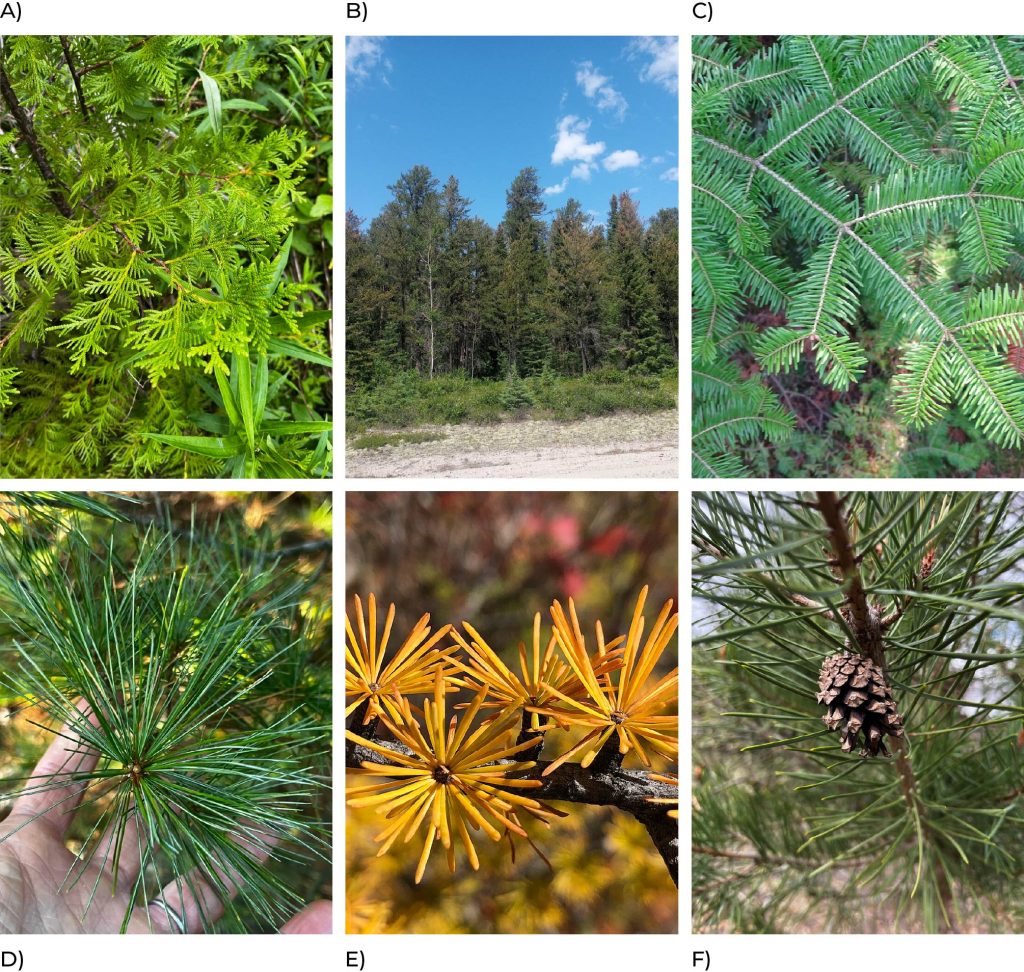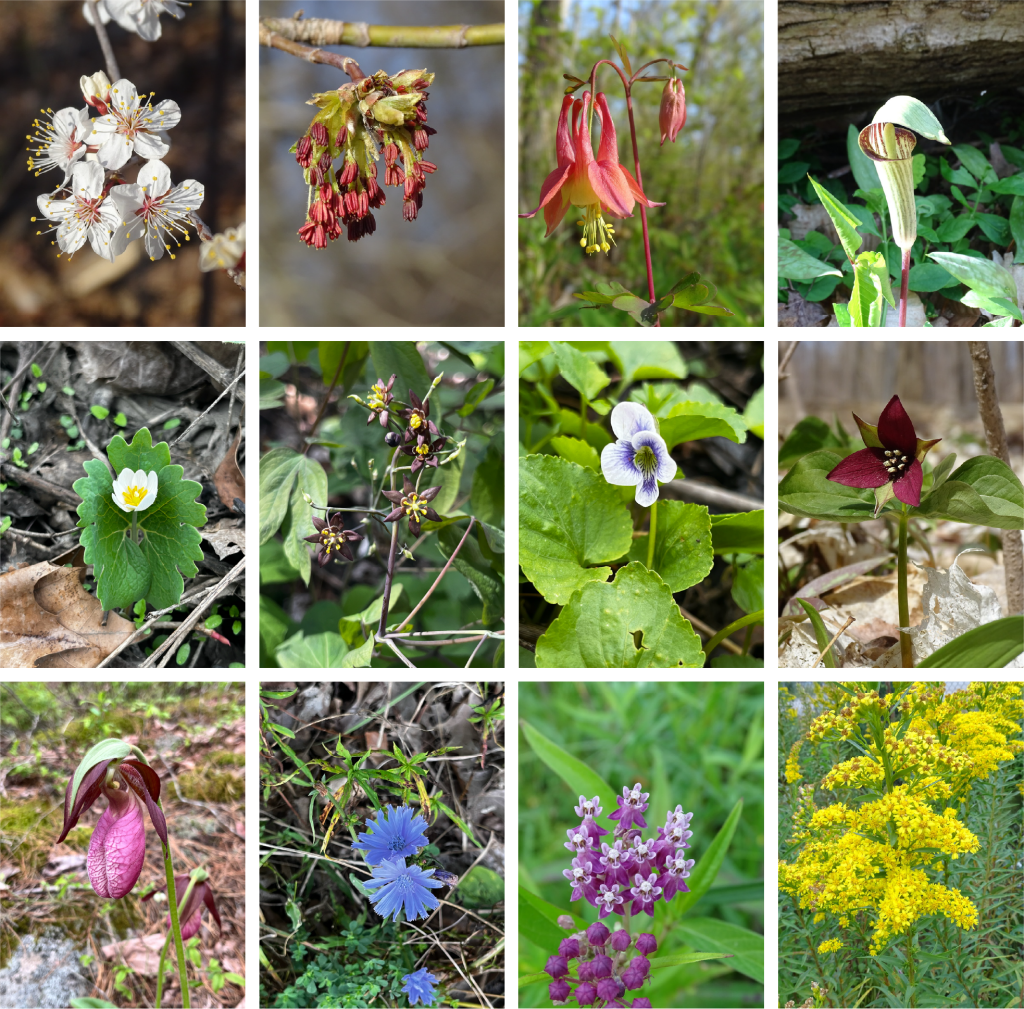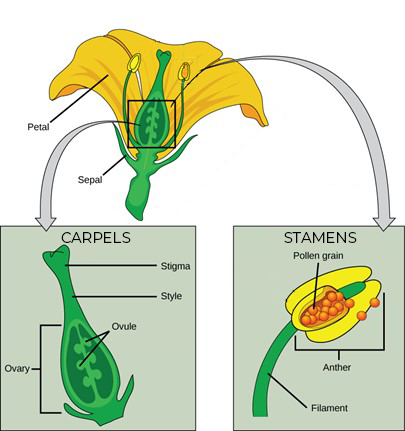5.2 Major Plant Groups
As plants began to colonize land, they evolved additional adaptations that helped them survive and reproduce in terrestrial environments. These adaptations vary among different plant groups and help define their unique characteristics. In this section, we will focus on four major groups of land plants: nonvascular plants (bryophytes), seedless vascular plants, seed plants (gymnosperms), and flowering plants (angiosperms).
Figure 5.2.1 Plant phylogeny showing major plant lineages and adaptations. Image by Shana Kerr, CC BY-NC-SA 3.0, Modifications: Removed Plantae lineage
Figure 5.2.1 Image Description
The image is a phylogenetic tree of land plants, showing their evolutionary relationships and key innovations.
- On the left, a branch labelled “Common ancestor of all land plants” leads to multiple lineages.
- Green algae is shown as the outgroup, diverging before land plants.
- Nonvascular plants (hornworts, mosses, liverworts) are the earliest land plants, marked by the development of a cuticle.
- Next, seedless vascular plants (ferns, lycophytes) evolved, associated with the appearance of true roots, vascular tissue, and lignin.
- Seed plants are split into:
- Gymnosperms, defined by the evolution of pollen and seeds.
- Angiosperms (flowering plants), defined by the evolution of flowers and fruits.
Additional side labels group vascular plants (including seedless vascular plants, gymnosperms, and angiosperms) and seed plants (gymnosperms and angiosperms).
This diagram highlights the evolutionary milestones that shaped plant diversification from green algae to modern flowering plants.
Nonvascular Plants (Bryophytes)
Nonvascular plants, also known informally as Bryophytes, appeared around 490 million years ago and are the closest living relatives of early terrestrial plants. Their major adaptations to life on land include a waxy cuticle and root-like structures called rhizoids. Rhizoids anchor the plant, but they lack vascular tissue and do not actively absorb water. As a result, bryophytes must live in very moist environments. They are also heavily dependent on water because their sperm are flagellated, so they require water for mating (sperm must swim in water to find the egg). Bryophytes are very short because they have no mechanism for transporting water up against gravity.
The bryophytes are divided into three groups: liverworts, hornworts, and mosses. There are about 18,000 species of bryophytes, but the majority are mosses, so they will be the focus of this section.
Mosses are commonly found in moist, shaded environments such as forest floors, where they often carpet the soil, bases of trees, rocks, and fallen logs. They are also abundant in wetlands where they grow in dense mats that act like sponges – trapping water, slowing its flow and filtering out sediment. In the tundra, their shallow rhizoids allow them to anchor to surfaces without digging into the frozen soil. They help reduce erosion, retain moisture and nutrients, and provide shelter for small animals as well as food for larger herbivores. Their small size and dense growth help insulate them from the cold. Mosses can also dry out and go dormant, then reactivate when conditions improve.

Moss Life Cycle
In a bryophyte, the conspicuous vegetative part of the plant is the gametophyte. The sporophyte grows from the gametophyte. It is less noticeable and can only be seen seasonally. It often grows in the spring or early summer, releases spores, then withers and detaches. In the image below, the gametophyte (haploid) structures are shown in green, and the sporophyte (diploid) in brown. Click on each hotspot to view each step of the lifecycle.
Text Description
Diagram of moss alternation of generations showing diploid sporophytes (2n) producing spores by meiosis, which grow by mitosis into male and female gametophytes (1n). Male gametophytes produce sperm, and female gametophytes produce eggs; fertilization forms a diploid zygote that grows into a new sporophyte, completing the cycle.
Clickable hotspots:
Step 1: Gametophytes (n) produce gametes (n) through mitosis. Antheridium produces sperm. Archegonium produces egg.
Step 2: Sperm swim to nearby gametophytes to fertilize egg in the antheridium, forming a zygote (2n).
Step 3: Zygote develops into embryo, which then grows (through mitosis) into new sporophyte (2n).
Step 4: Sporophyte (2n) produces spores (n) through meiosis.
Step 5: Spores blow to a new location and grow into a new gametophyte (mitosis). The gametophyte is the conspicuous part of the plant.
Seedless Vascular Plants
Seedless vascular plants appeared around 430 million years ago and represent a major evolutionary step in plant adaptation to life on land. Compared to nonvascular plants like bryophytes, seedless vascular plants have three key adaptations:
- True roots grow deeper into the soil than the rhizoids of bryophytes. This allows seedless vascular plants to absorb more water and nutrients. Many also form partnerships with mycorrhizal fungi (more information in section 5.3), which help them extract even more resources from the soil.
- Vascular tissue consists of two types of specialized cells: xylem, which transports water from the roots to the leaves, and phloem, which distributes sugars made during photosynthesis throughout the plant. This internal transport system allows seedless vascular plants to grow much taller than bryophytes and thrive in more diverse environments.
- Lignin is a tough, rigid substance that hardens cell walls. It provides structural support and allows plants to stand straight up.
These features allowed seedless vascular plants to grow larger and colonize drier environments. That being said, like bryophytes, seedless vascular plants still rely on water for reproduction. Their sperm are flagellated and must swim through water to reach the egg, so these plants are still most common in moist environments.
The seedless vascular plants include club mosses, horsetails, and ferns (Figure 5.2.3). Seedless vascular plants are commonly found in shaded forests, wetlands, and other damp habitats. With their large fronds, ferns are the most readily recognizable seedless vascular plants. About 12,000 species of ferns live in environments ranging from the tropics to temperate forests.

Fern Life Cycle
Seedless vascular plants have a sporophyte-dominated life cycle, meaning the large, visible plant is the diploid sporophyte. This sporophyte produces haploid spores that grow into small, short-lived gametophytes.
Sporophyte tissues, which are usually but not necessarily diploid, are shown in green. Gametophyte tissues and spores, which are often but not necessarily haploid, are shown in brown. Spores are generated by meiosis in sporangia. Gametes, both eggs and sperm, are generated by mitosis in archegonia and antheridia, respectively. For simplicity, fertilization is depicted between an egg and sperm from the same gametophyte, but fertilization is also likely to occur between gametes from different gametophytes that are derived from the same or different sporophytes. Click on each hotspot to view each step of the lifecycle.
Text Description
Diagram of the alternation of generations in ferns. On the left, the diploid sporophyte (2n, green) produces spores in sporangia through meiosis. The spores develop into a haploid gametophyte (n, brown). The gametophyte contains antheridia that produce sperm and archegonia that contain eggs, formed by mitosis. Fertilization occurs when sperm swim to the egg, creating a zygote (2n), which grows into a new sporophyte, restarting the cycle.
Clickable hotspots:
Step 1: Gametophytes (n) produce gametes (n) through mitosis. Antheridium produces sperm. Archegonium produces an egg.
Step 2: Sperm swim to nearby gametophytes to fertilize the egg in the antheridium, forming a zygote (2n).
Step 3: Zygote develops into an embryo, which then grows (through mitosis) into a new sporophyte (2n). The sporophyte is the conspicuous part of the plant.
Step 4: Sporophyte (2n) produces spores (n) through meiosis.
Step 5: Spores blow to a new location and grow into a new gametophyte (mitosis).
Gymnosperms
Gymnosperms, or “naked seed” plants, first appeared around 350 million years ago and represent a major evolutionary advancement in plant reproduction. They possess all the adaptations of seedless vascular plants, but also have two additional adaptations that allowed them to thrive in drier environments:
- Pollen is a protective structure that carries sperm cells. Unlike the flagellated sperm of mosses and ferns, gymnosperm sperm do not need to swim through water. Instead, pollen is carried by the wind to reach the female part of the plant. This adaptation allows gymnosperms to reproduce in dry conditions.
- Seeds protect the developing embryo. A seed contains a food supply and a protective outer coat that protects the embryo against desiccation (drying out). Seeds can also remain dormant until the environment is right for growth.
There are only around 1000 living species of gymnosperms, and the majority of them are conifers. Conifers are tall trees with needle-like leaves. Water evaporation from leaves is reduced by their narrow shape and a thick cuticle. Snow easily slides off needle-shaped leaves, keeping the snow load light and reducing broken branches. Such adaptations to cold and dry weather explain the predominance of conifers at high altitudes and in cold climates. Conifers include familiar evergreen trees such as pines, spruces, firs, cedars, sequoias, and yews. A few species, like tamaracks, are deciduous and lose their leaves in fall. Many coniferous trees are harvested for paper and timber.

Pine Life Cycle
In a typical gymnosperm life cycle, the large, visible tree is the diploid sporophyte. It produces male cones (which make pollen) and female cones (which contain ovules). After fertilization, the ovule develops into a seed. Click on each hotspot to view each step of the lifecycle.
Text Description
The diagram illustrates the pine life cycle in a circular sequence. At the top, a mature sporophyte tree produces male cones (pollen cones) and female cones (seed cones). The male cones release pollen grains (male gametophytes), which fertilize the eggs contained in female cones. Fertilization produces a zygote, which develops into an embryo inside a seed. The seed germinates into a young sporophyte, which grows into a mature pine tree, completing the cycle.
Clickable hotspots:
Step 1: Gametophytes (n) produce gametes (n) through mitosis. Male gametophyte is a pollen grain found in male cones. Female gametophyte develops within an ovule in female cones.
Step 2: Pollen is carried by wind to fertilize the egg, forming a zygote (2n) inside the ovule of the female cone.
Step 3: Zygote develops into embryo. Ovule develops into seed.
Step 4: Seed is dispersed, then germinates and grows (through mitosis) into new sporophyte (2n). The sporophyte is the conspicuous part of the plant (the tree).
Step 5: Sporophyte (2n) produces spores (n) through meiosis. Spores develop into gametophytes inside of cones.
Angiosperms
Angiosperms, or flowering plants, are the most diverse and widespread group of plants on Earth, with over 300,000 known species. They first appeared around 130 million years ago and now dominate most terrestrial ecosystems. Angiosperms include nearly all the plants we eat (e.g. grains, fruits, vegetables, nuts) as well as most ornamental plants. Like gymnosperms, angiosperms have seeds and pollen, but they also have two additional adaptations that make them especially successful:
- Flowers are specialized structures that help with reproduction. They attract pollinators like insects, birds, and bats, which carry pollen from one flower to another. This is more efficient than relying on wind and increases the chances of successful fertilization.
- Fruits are any structure that develops from a flower ovary and helps in seed dispersal, such as something sweet that is eaten by an animal so that the seed is deposited somewhere new in the feces (and with its own personal supply of fertilizer!). Fruits thus provide a mechanism for seeds to colonize new territories away from the parent plant.
Flowers
Flowers use a variety of strategies to spread pollen. Some rely on the wind by releasing lots of lightweight pollen into the air. Others have evolved to attract pollinators. Bright colours like red, yellow, and purple catch the attention of bees, butterflies, and birds. Many flowers produce nectar, a sugary liquid, to provide pollinators with a reward to encourage visits. Others use mimicry, imitating the look or scent of something else, like a female insect, to trick pollinators into stopping by. Some flowers even produce strong, unpleasant odours that smell like rotting meat to attract carrion flies or beetles. These diverse adaptations increase the chances of successful pollination.


Although they come in many shapes and colours, most flowers share the same basic parts:
- Sepals are the outermost parts of the flower. They are usually green and protect the flower bud before it opens.
- Petals are located just inside the sepals. They are often brightly colored to attract pollinators.
- Stamens are the male reproductive parts. Each stamen has a thin stalk called a filament and a top part called an anther, where pollen is made.
- Carpels (also called pistils) are the female reproductive parts. A carpel includes:
- Stigma – a sticky surface where pollen lands
- Style – a tube that connects the stigma to the ovary,
- Ovary – which contains one or more ovules. Each ovule holds an egg and will become a seed after fertilization.
Life Cycle of an Angiosperm
Similar to gymnosperms, the large, visible plant for angiosperms is the diploid sporophyte. The male and female gametophytes are tiny and develop inside the flower. Click on each hotspot to view each step of the lifecycle.
Text Description
Diagram of the angiosperm life cycle showing meiosis and mitosis producing female gametophytes (embryo sac with egg) and male gametophytes (pollen grains). During pollination, pollen grows a tube to deliver sperm to the egg for fertilization, forming a zygote that develops into a seed and germinates into a mature flowering plant.
Clickable hotspots:
Step 1: Gametophytes (n) produce gametes (n) through mitosis. The male gametophyte is a pollen grain in the anther of a flower. The female gametophyte (embryo sac) develops inside an ovule within the ovary of a flower.
Step 2: Pollen is transferred (by wind or pollinators) to the stigma of a flower, where it grows a pollen tube to fertilize the egg inside the ovule, forming a zygote (2n). This process includes double fertilization – a second sperm fertilizes a nearby cell to form endosperm, which nourishes the embryo.
Step 3: The zygote develops into an embryo. The ovule becomes a seed, and the ovary develops into fruit.
Step 4: The seed is dispersed, then germinates and grows (through mitosis) into a new sporophyte (2n). The sporophyte is the visible flowering plant.
Step 5: The sporophyte (2n) produces spores (n) through meiosis. Spores develop into gametophytes (pollen and embryo sacs) inside the flower.
Fruit
After fertilization, the ovule develops into a seed, and the surrounding ovary develops into the fruit. That means that a fruit is a ripened ovary that contains one or more seeds. Many foods we call vegetables are actually fruits because they come from the ovary and contain seeds (e.g. eggplants, zucchini, string beans, and bell peppers). Even acorns and maple keys (called samaras) are considered fruits.
Fruits come in two main types:
- Fleshy fruits are soft and juicy (e.g. berries, peaches, tomatoes).
- Dry fruits are hard or papery when mature (e.g. nuts, rice, wheat).
Some fruits form from a single ovary (e.g. apple) while others form from multiple ovaries in one flower (e.g. raspberries). Still others develop from clusters of flowers (e.g. pineapples).
Fruits play an important role in seed dispersal. Their shapes and features reflect how they spread:
- Wind dispersal: Lightweight or winged fruits that are carried by the wind (e.g. dandelions and maple keys)
- Animal ingestion: Colourful, sweet, and juicy fruits are eaten by animals then the seeds are later dropped in their feces (e.g. most fleshy fruits)
- Animal transportation: Some fruits have hooks or burs that stick to fur or clothing and get carried away (e.g. burdock)
- Water dispersal: Floating fruits travel across water to new locations (e.g. coconuts)
Knowledge Check
Text Description
1. Which of the following features is found in gymnosperms but not in seedless vascular plants?
- True roots
- Vascular tissue
- Pollen
- Fronds
2. In which plant group is the gametophyte the dominant and most visible stage of the life cycle?
- Angiosperms
- Gymnosperms
- Seedless vascular plants
- Bryophytes
3. What adaptation allows angiosperms to disperse their seeds more effectively than gymnosperms?
- Pollen
- Flowers
- Fruits
- Spores
4. Which of the following is true of seedless vascular plants but not bryophytes?
- They rely on water for fertilization
- They have lignin to support vertical growth
- They produce spores
- They live in moist environments
5. What is a key reproductive advantage that flowers provide to angiosperms?
- Flowers store water during drought
- Flowers produce food through photosynthesis
- Flowers attract pollinators, increasing fertilization success
- Flowers protect seeds from UV radiation
Answers:
- c. Pollen
- d. Bryophytes
- c. Fruits
- b. They have lignin to support vertical growth
- c. Flowers attract pollinators, increasing fertilization success
OpenAI. (2025). ChatGPT. [Large language model]. https://chat.openai.com/chat
Prompt: Create 5 multiple-choice questions using the following content
“14.2 Seedless Plants” from Biology and the Citizen by Colleen Jones is licensed under a Creative Commons Attribution 4.0 International License, except where otherwise noted. Modifications: Edited and reworded
“Organismal Biology” by Georgia Tech Biological Sciences is licensed under a CC BY-NC-SA, except where otherwise noted. Modifications: Edited and reworded


